PHP Interview Questions

Outline
This is a comprehensive guide on PHP developer interview questions. It has three sets of important PHP interview questions and answers: Beginners, Intermediate and Advanced.
With the help of our sure-fire PHP interview preparation guide, you can ace your upcoming interview and land your dream position as a PHP developer.Introduction - PHP Interview Questions and Answers
PHP is the most popular server-side programming language heavily utilized for web development practice. According to research around 80% of active websites are built on top of PHP making it a popular choice for server side programming.
It’s a general-purpose scripting language that is fast, pragmatic, and flexible. This is why all CMS platforms like WordPress, Joomla, and Drupal are built using PHP. With such widespread use companies recruit PHP developers on a large scale.
Optymize is a US-based company with global clients. We offer 100% remote opportunities as well as competitive payments. Sign up with us, crack the interview and work with Fortune 500 Companies.
PHP Interview Questions and answers For Beginners
With practice, you will be able to respond to basic PHP interview questions with ease as a developer.
We have gathered some challenging PHP Developer interview questions for you in this part. You can get assistance from this section with these precise types of intermediate PHP interview questions you might face while looking for work.
1. Define PHP Session
2. How to define constants in PHP?
A define() function can be used in PHP to define and retrieve the value of the constants. It can be done by specifying its name.
echo MAXSIZE;
3. What is the difference between constants and variables?
| Constants | Variables |
|---|---|
| The value of constants can't be changed during execution | The value of constants can be changed during execution |
| It doesn't require a $ sign before using any constant | It requires a $ sign before using in variable |
| Constants can't be defined by assigning, they require define() function | Variables can be easily defined by assigning |
| The constants can be accessed from anywhere in the code | Variables can be only accessed from their current state scope |
4. How to convert string components into array components?
To convert string elements into array elements we can use explode() function that breaks a string into an array. Each array element is a substring of string formed by separating it on boundaries formed by the string delimiter.
5. How to concatenate two or multiple strings?
To concatenate two or multiple strings dot(.) operator is used.
$string2 = “Nick”;
echo $string1 . ” ” .
$string2;
Output
Hi! i am Nick
6. What is PEAR?
PEAR is a framework and a repository for all PHP reusable components. It facilitates higher-level programming for web application developers and has all snippets and code libraries. It also consists of a command line to install packages and libraries automatically.
7. Differentiate between print and echo.
| Echo | |
|---|---|
| Print is slow compared to echo | Echo is faster compared to print because it doesn't return any value |
| Print can only output one string and returns 1 | Echo can output multiple strings |
| To pass values parenthesis is not required with arguments list | To pass multiple parameters with echo parenthesis is required |
7. How can we reverse a string?
To reverse a string strrev() function is used.
Output:
!dlroW olleH
Intermediate PHP Questions and Answers
With practice, you will be able to respond to basic PHP interview questions with ease as a developer.
We have gathered some challenging PHP interview questions for you in this part. You can get assistance from this section with these precise types of intermediate PHP interview questions you might face while looking for work.
1. What is a trim() function?
2. Why do we need a Parser?
A parser is computer software that converts the source code into machine-readable code so the computer can easily interpret the code and execute tasks accordingly.
To Parse code using PHP we can use token_get_all() function.
3. What is the difference between str_replace() and str_ireplace()?
The str_replace() function is a case-sensitive function that replaces the string that matches the string.
Whereas the str_ireplace() function doesn’t have a case sensitive rule, it treats each case or combination of both as a single. However, this function tends to be a bit slow compared to str_replace because it converts cases to be the same.
4. Which method is used to hash passwords in PHP?
The crypt() function is the most used method to hash passwords in PHP. It provides a large number of hashing algorithms and includes sha1, sha256, or md5 which are fast and efficient.
5. What is the difference between === and == operators?
The === operator performs typesafe operations which means it returns true if both operands have the same type and the same value.
Whereas the == operator casts between two different types if their values differ.
Example:2 == 2: true
2 === “2”: false // 2 is an integer, “2” is a string
2 == “2”: true // “2” gets casted to an integer, which is 2
“foo” === “foo”: true // both operands are strings and have the same value
6. How do the include() function and require() function differ from each other?
Most of the time include() functions and require() function executes similar tasks.
However, the slight difference between the two is that the include() function generates a PHP warning but grants script execution to proceed in the file to be added cannot be found. At the same time require() function generates a fatal error to terminate the script execution.
7. How to print an array in PHP?
The print_r() is one of the methods to print an array in PHP
‘australia’, ‘b’ =>
‘brazil’, ‘c’ =>
‘canada’ (‘x’, ‘y’, ‘z’));
print_r ($a);
Output:
Array
(
[a] => australia
[b] => brazil
[c] => canada
- (
- [0] => x
- [1] => y
- [2] => z
- )
Advanced PHP developer Interview Questions
1. What are the different methods to handle the result set of MySQL?
| Command | Task |
|---|---|
| mysqli_fetch_assoc() | It returns the result set of the current row as an associative array |
| mysqli_fetch_array() | It returns the result set of the current row as an associative array, numeric array, or both |
| mysqli_fetch_object() | It returns the result set current row as an object |
| mysqli_fetch_row() | It returns result set of a row as an enumerated array |
2. What is type hinting in PHP?
Type hinting helps define specific data types such as an array, interface, and objects for an argument in a function declaration.
PHP checks whether the argument matches the user’s preferred type, whenever the function is called. If it doesn’t match the type, the runtime displays an error message and the program will stop executing. It helps in organizing code and improving error messages.
3. Explain session_start() and session_destroy().
The session_start() is used to start a session. It can resume a session if the existing session is stopped then the return will be the current session when it will be resumed.
syntax:Whereas, the session_destroy() is used to destroy the session variables.
Syntax:<?php
session_start();
session_destroy();
?>
4. How to use cURL?
cURL is a library that allows us to make an HTTP request in PHP.
Code to implement cURL:curl_setopt($curl_handle, CURLOPT_URL,
‘http://www.google.com’);
curl_setopt($curl_handle,
CURLOPT_CONNECTTIMEOUT, 2);
curl_setopt($curl_handle,
CURLOPT_RETURNTRANSFER, 1);
$buffer =
curl_exec($curl_handle);
curl_close($curl_handle);
if (empty($buffer)) {
print “Nothing
returned from url.
“;
} else {
print $buffer;
}
To run it however we have to use the command line.
php < myphp.phpConclusion
Whether you’re a developer getting ready for an interview or a hiring manager trying to find the ideal candidate, we believe these PHP interview questions and answers will be a tremendous help to you during the process.
Keep in mind that technical proficiency is only one aspect of the hiring process. Both prior experience and soft skills are essential if you want to be hired for a high-paid web development position.
Keep in mind that many of the PHP interview questions are open-ended. Not just the answer you memorized, but also your reasoning will be of interest to the interviewer. Always be prepared to address any follow-up inquiries about how you came to your conclusion. Describe the way you think.
Good Luck! Regarding your future PHP interview. You can browse through our listings for PHP developer jobs here.





